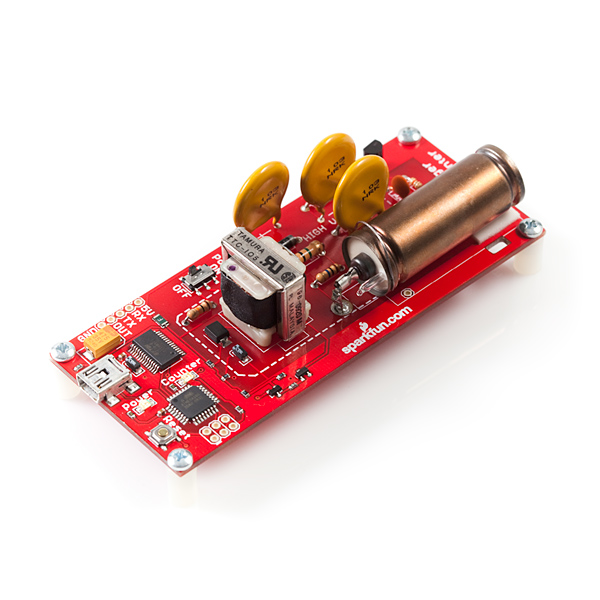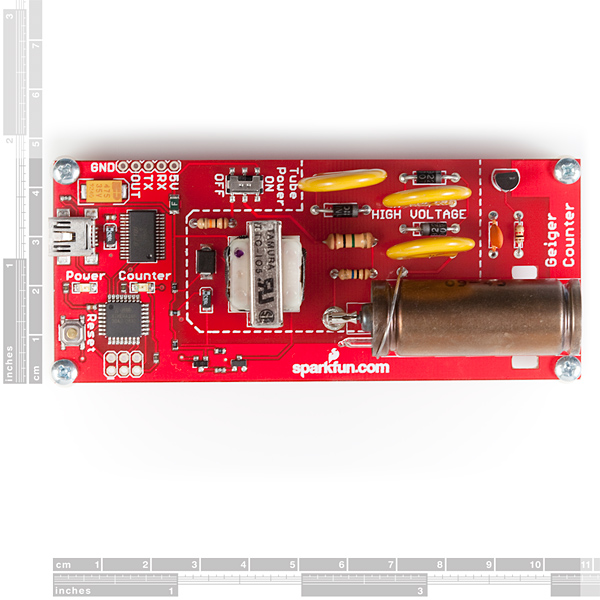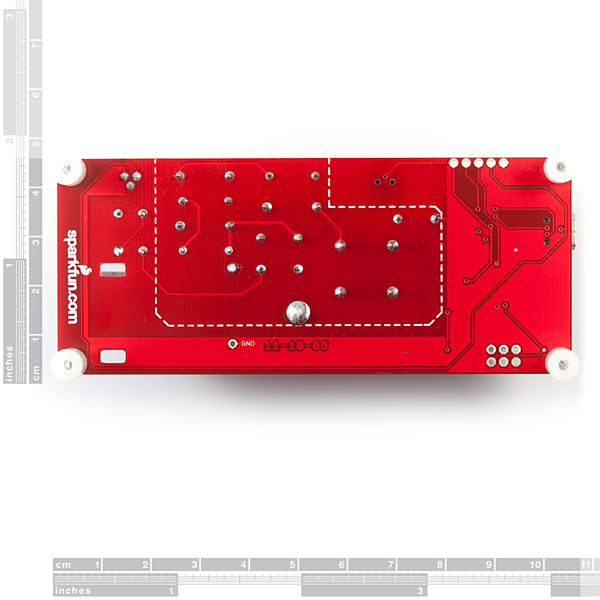Geiger Counter (Old-School)
Replacement:SEN-09848. We've made some minor changes to the board layout, but functionality remains the same. This page is for reference only.
This is a USB powered Geiger Counter equipped with an ATMega328 that can be programmed in circuit using one of the programmers below. Simply plug the unit into USB (make sure you have FTDI drivers installed), open a terminal program to the correct COM port at 9600bps, and you will see random bits being generated from the random background radiation. Here at SparkFun, on average, we get about 20 counts a minute.
Check out the random number generating Geiger counter tutorial for more information.
Note: While the Geiger counter is powered and the switch is in the ON position, the board contains exposed high voltage components. In order to turn the unit off, you must flip the tube power switch to OFF while the USB cable is plugged in or while the board is still connected to your power supply. The reason being; when you move the switch into the OFF position, the high voltage lines are bled out through a resistor connected to ground, more information on this in the tutorial.
A project box or enclosure is suggested. Do not touch the end window of the Geiger tube and do not to touch any conductive region inside the area marked HIGH VOLTAGE when the Geiger tube is powered ON. An enclosure is not absolutely necessary, but if you choose not use an enclosure, remember to be extra careful with the end window and high voltage regions.
The Geiger tube comes with a red boot to protect the end window during, production, handling, and shipping. The boot should be removed if you are needing to detect alpha particles. However, you should still see activity from gamma and beta particles even with the boot on.
For older revisions with a bleed button: Remember to always hit the bleed button with your power supply connected, after the tube power switch is moved from the ON position to the OFF position.
Features:
- 5V@30mA input
- LND712 Geiger tube
- ATMega328
- FTDI USB
- Power and status LEDs
- TTL output pin from tube
- 4.15"x1.75"x1" (without standoffs)
Comments
Looking for answers to technical questions?
We welcome your comments and suggestions below. However, if you are looking for solutions to technical questions please see our Technical Assistance page.
Customer Reviews
No reviews yet.




Now where can I get a little electronic clicker that sounds like a classic geiger counter to attach to this?
I've found that those little piezo buzzers make some nice clicky sounds, just hook them up to a digital output or the out pin on this thing and you should get some of that classic clickiness
You could probably use one of the relays here on sparkfun, or the buzzers.
Placing the Geiger tube inside a case will make it mostly insensitive to alpha radiation and inhibit beta radiation. If you cut a hole for the front face of the Geiger tube, it's dandy. But, it's not omnidirectional for alpha and beta.
You'll want to get a radiation source to increase the number of readings. I recommend United Nuclear:
https://unitednuclear.com/index.php?main_page=index&cPath=2_5
This Geiger tube is well suited to have an isotope disk source placed directly in front of it's detection window. But, beware of maximum detection rates.
Also, Nuclear Safety for kids:
http://meaning.com/wiki/Image:Ghosted-eliz-cs-137.JPG
Unless of course your case is made out of diamonds.
Whats the easiest way to use this in a non USB format. Ideally I want to use mine to just generate random trigger voltages. I have 5v rail, do I just hook up the 5v to 5v and ground to ground and then the outs from the out pin? What out voltage and amperage would that give me?
Seems too easy.
Also if I want to mount behind a faceplate, I'm assuming mounting it perpendicular and then having a small window in the faceplate above where the tube is would be sufficient to get "radiation" into the tube to get it to fire?
What is the sensitivity of this tube for alpha radiation in MeV?
so i just go my counter, it was shipped last week, how can i tell what firmware version does it have? and, in case i need to upgrade, is there any step by step guide on how to flash it? I might like to test the code submitted by hb8 below.<br />
<br />
thanks for any pointers in advance!
It will have the same firmware that's listed on this product page.
thanks! now i'm wondering if someone here could take a minute to describe the steps to flash it with the code that hb8 developed. Tx!
hb8: Try this: geigerTest001.c<br /><br />
<br />
hi hb8, i will try your code as soon as i get my counter. after i read your reference to the futurists i was wondering if you are up for some sort of collaborative noisyfication :) I will be collecting numbers in Switzerland looking fwd to play with them as a guide to some musical score.<br />
<br />
could'nt find a contact email on your site, that's why i have to trust you will get back and read this comments.<br />
<br />
RobertC.: It's coming up in a new software revision. Check the GitHub page for the new firmware (when it comes out): http://github.com/a1ronzo/SparkFun-Geiger-Counter
I see new firmware (beta) has been released... but it needs compiled. Any help here? Counts/Second are okay but Counts/Minute is something we know (unless you've got a very radioactive source sitting on top of it).
This is an incredible product! But... I really thought there would be more interest and support (actual programs - not just C code that I have no way of compiling).
Right at $150 plus shipping and it's still sitting in the anti-static bag it shipped in. I can't use it other than to make 1's or 0's appear in a terminal window. Calling it a "Geiger Counter" is a bit misleading as it does nothing of the sort.
Is there anyone here who has this working as a functional "Gieger Counter"?
Try this: geigerTest001.c
Nice. BUT... okay, I can see 1's and 0's in a terminal window but where are any programs that produce a CPM or at least something useful?
I have several Geiger Counters and this is very sensitive. I'm not a programmer so I'm looking for some support on this product. A simple program for CPM isn't too much to ask for is it? Add in logging capability with ability to export for importing into a graphing program and THIS is a winner! Thanks...
It's coming up in a new software revision. Check the GitHub page for the new firmware (when it comes out):
http://github.com/a1ronzo/SparkFun-Geiger-Counter
I'm curious about the power requirements as well. I just got mine in the mail two days ago and I've tried it on two different USB hubs now. In both cases, while the counter appears to power up, other devices on the hub, such as cooling fans, shutdown. The counter was never recognized as a new device on either system either.
I'm wondering if it has a very high power requirement, or whether the unit I got has a subtle short in the USB jack.
I got a reply from sparkfun tech support, the board should only draw about 30ma, mine was tripping the current limiting on my bench supply at over 800ma. I guessing something is shorted in the USB controller part of the board.
At 30ma though, you should be able to power it from a battery fairly well, or even with a few solar cells.
That might be power to ground short.
Any idea on the power requirements? Looking to battery operate it...
How would I be able to use this with this pool pump system? Pentair Intelliflo Pump: http://www.sunplay.com/Pentair-IntelliFlo-Variable-Speed-Pump-011018-p/011018.htm
Unless you're pumping fluid in a nuclear reactor, I have no idea what a Geiger counter has to do with a pool pump... but I'd love to hear it!
Running off a battery shouldn't be a problem. We did it here with one AA and a booster.
The random number generator code goes to a nonexistent github page.
What does the output look like?
Hi there, yesterday I received mi GM Counter order#226919. It worked nice for a few hours, but then it gave a spark sound and the FT232 began to smoke, the PC attached to it hung up, and the Atmega186 bekame very hot. I took the FT232 out and found that the only working part was the HV supply. I asume that the 500V discharged against the 5V supply in the little switch, wich I'm shure is not designed to handle such high voltage, and bourned both IC. Can you please give an email address the get in contact with Sparkfun for a replacement or repair??
Walter Strasser
I had the exact same issue. Bought unit back in mid_March but only now got to it since I was away from home. Plugged it in and 10 minutes or so later zap! My Mac complained that a device on USB drew too much power and was about to damage my Mac so it was shutdown.... What happened next in your case? Was your geiger counter replaced? Thanks
That definitely doesn't normally happen, sorry about that. This is the first SparkFun has heard of the issue.
Please email techsupport@sparkfun.com, also if anyone else has encountered the same issue please email tech support and let us know. If there is enough of the same issue out there it is something worth re-engineering.
Sparkfun, design a modern version of
http://www.techlib.com/area_50/enricosprojects.htm#Worlds Smallest
(PIN photodiode, radiation detector)
no high voltages included, and cheap
I'm wondering if you could describe how your voltage multiplier works, it seems to be quite similar to a Villard cascade of doublers but not quite. I'm suprised you're able to take 5V and get it up in the 450V range with so few stages...
I've assumed the transformer is 1:1 and used only for isolation but perhaps I'm wrong and this is providing a voltage step up?
I guess it would help to clarify what value is assumed for Vcc.
If you build the circuit shown in the schematic and it doesn't work, try reversing the connections to the primary on the transformer. (The common connection between the primary and secondary uses the opposite phase of each winding.)
I would like to use one of these to detect something like paint on a steel cable, to detect the cable position when moving between pulleys (Virtual cable stops without putting 'bumps' on the cable).
Is there some sort of liquid paint-like substance that I can purchase, which this thing will detect?
TIA.
Just a suggestion as I did some research on measuring both speed and displacement on steel cables. Check out this website. http://www.polytec.com/usa/158_289.asp
These systems are expensive but do the job very well.
Well... if you mix an element that can be easily ionized in the paint. That way you'd be able to detect the ionizing radiation from the paint probably. I don't know for sure as I don't have much chemistry knowledge. I would say, that be one expensive cable detector or whatever you want. Anyway, the Geiger counter can detect many things, whats important is you knowing what you are detecting depending on the energy spectrum of the beta particles. I could attach a small drawing/diagram of how I would build my beta ray spectrometer by using stuff sold at sparkfun.
A few guys in the comments over at hack a day have expressed concern over an alleged lack of isolation between high voltage and data lines in an article on your new geiger counter. http://hackaday.com/2009/10/21/hackable-geiger-counter/
I do not have the expertise necessary to know whether they're right or not but if they aren't (or are) you might want to comment on the article yourself! There is plenty of praise in the comments, too.
Thanks for the great feedback!
Opto-isolating the high voltage from digital line is a great idea and we will take that design suggestion into consideration for the next rev.
However, the current design works great and I have been using my 1st proto since earlier this year without problems. Isolating the high voltage from the digital might not be completely necessary when you take extra precaution with physically isolating the digital line from high voltage lines.
Your suggestions are greatly appreciated, keep 'em comin!
If you attach an electromagnet on the side of the geiger muller tube and have the radioactive source between the tube and the electromagnet, you can, by varying the magnetic field (from small to big preferably), do a beta spectroscopy. Depending on the magnetic field intensity, different energy particles will go in an half circle trajectory around the electromagnet and hit the geiger counter. Thus, by counting a time T for each energy level, you can get the specter of your source and thus, analyze what the radioactive source is. A geiger tube like this will only tell you if there are beta particles present (electrons or positrons). Also, beta particles shouldn't be harmful to the human body, gamma particles are the ones I would fear.
Oh yeah, you seem to have a 47pf resistor in the schematic...!
And shouldn't the transformer secondary be grounded?
One of those Coleman gas lantern mantles should have enough thorium to give a lively count rate...
Are there any plans to sell this without the tube? I have 15 tubes already that I would like to use :)
Holy Cow! Awesome! I want one! :)